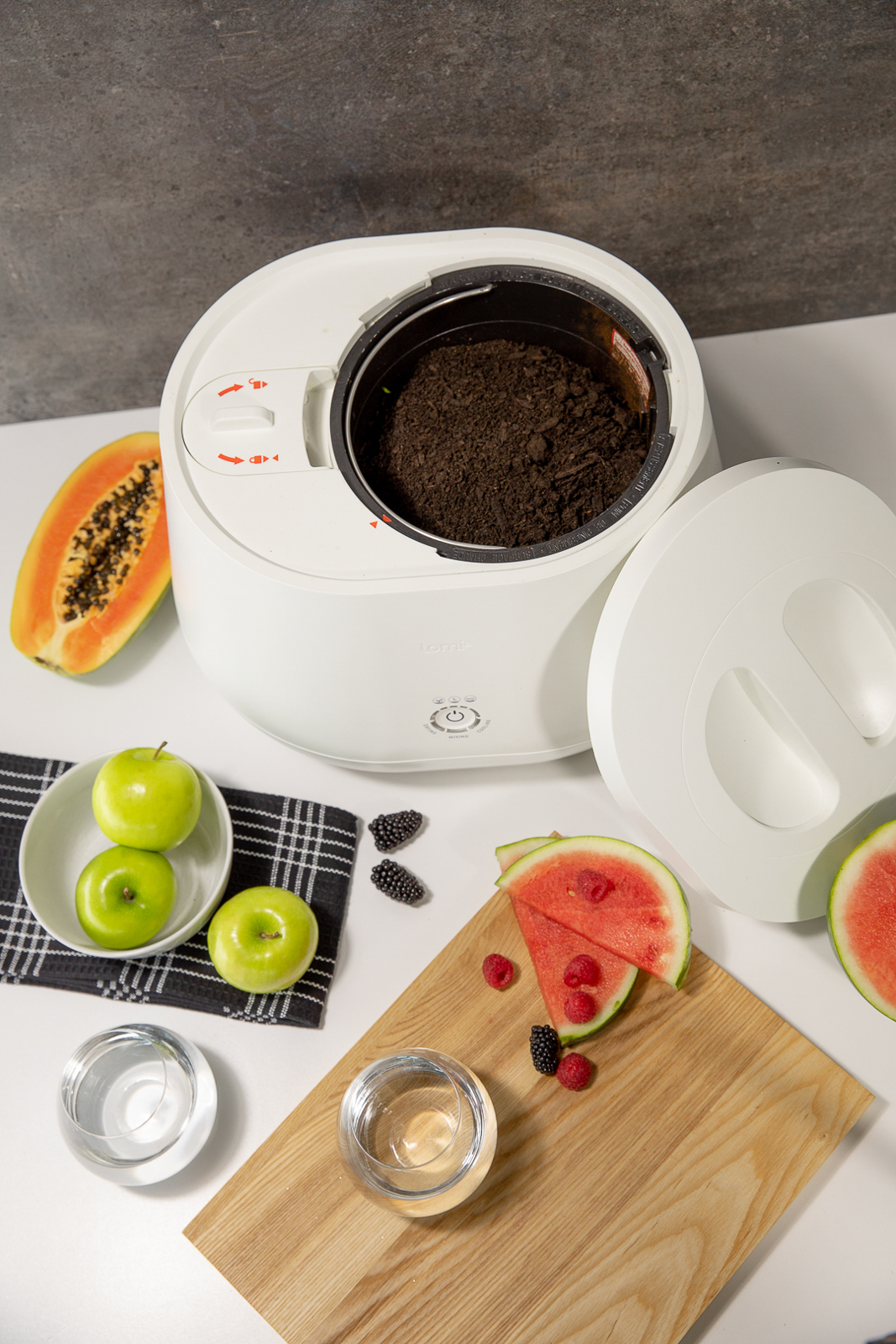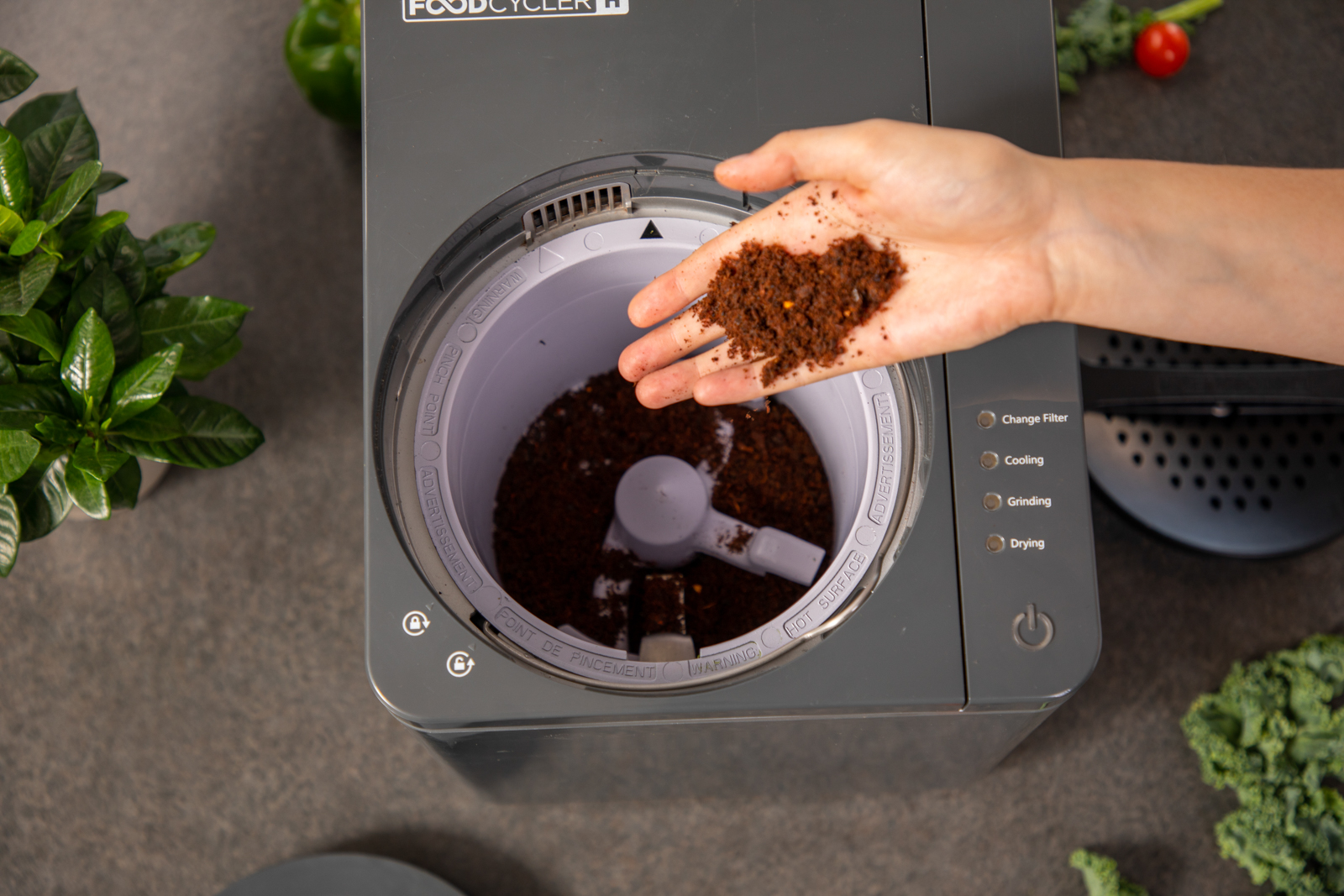Sometime later this year, the small Kootenay mountain community of Nelson, B.C., will become the first city in the world to begin dehydrating all its kitchen scraps. Every household in the municipality of 11,000 will be issued an electric countertop composter in a program drily called “the home-pre-treatment model of organic waste management.” In effect, that means loading food waste into a small machine that in the course of a few hours turns it into what looks like dry dirt.
What prompted the “Queen City of the Kootenays” to make this radical move? Unlike big metropolitan areas such as Vancouver, where waste systems can handle thousands of tons of food waste a year, small communities can struggle to handle compostables collection with enough regularity to avoid a stinky, pest-attracting mess. But if scraps can be transformed into a dry, lightweight, odourless material, pickups can be more efficient, less frequent, and less smelly.
In 2017, the Regional District of Central Kootenay began looking at how to handle organic waste, eventually deciding to construct two composting facilities by 2022, one in Creston, the other in Salmo not far from Nelson. In 2019, while its municipal partners were agreeing in principle to adopt curbside organics collection, Nelson’s mayor and council also entertained a novel idea, asking residents to pretreat their kitchen scraps at home with a dedicated dehydrator before heading out the door.
In 2020, Nelson ran two successful pilot projects with the Canadian company Food Cycle Science, one for eco-keeners, the other for everyday Joes. After both of these groups enthusiastically embraced in-home organics processing, the city committed to a communitywide rollout. The City of Nelson has some of the most ambitious climate action targets in Canada—the town is legendary for its hippie roots—and organics diversion is a key strategy to achieving them.

The famously crunchy mountain town of Nelson, B.C. will the the first in the world to introduce universal countertop composting. Image courtesy of Nelson Chamber of Commerce.
Food Cycle is only one Canadian company trying to tackle the ubiquitous problem of what to do with the endless river of organics cascading out of residential kitchens and to challenge conventional ways of dealing with it—shoving it down the Garburator, chucking it in a bucket, or slinging it directly into a bin bag.
Each of these options has downsides. Garburators, on a slow road to oblivion in communities across North America, clog up and conk out. Countertop scraps bins, worthy if smelly pit stops for waste on its way to a city green can, are all-you-can-eat buffets for fruit flies. Food frivolously tossed in the garbage is booster juice for planet-killing methane gas, seeping out of landfills worldwide.
Not wanting to intentionally harm the planet or live with flying moochers and stink, I scoured the internet for an alternative to my kitchen waste protocols. What I found was surprisingly close to home. Lomi, a curvy electric countertop composter, is the brainchild of Pela, a team of British Columbia materials scientists and engineers in Kelowna.
Best known for making what it says are the world’s first compostable smartphone cases, the five-year-old company has earned a more than $100-million valuation and celebrity investors such as American music mogul Jay-Z with this product and other biodegradable accessories.
With the Lomi, Pela wades into the world of home food waste management, competing with everything from Garburators and municipal green bins to indoor worm factories and backyard composters, as well as industry giants such as Vitamix, which distributes Food Cycle Science’s FoodCycler FC-50. Lomi’s star has risen dramatically over the last year thanks to shoutouts and segments in American mainstream news media. Pela’s strategic digital marketing, which includes humorous and straight-shooting eco-conscious YouTube videos and social media influencer endorsements, hasn’t hurt either.
Pela shipped the first Lomis to its Indiegogo backers in December 2021 and has sold more than 75,000 units to date. I purchased my Lomi on its website earlier this year and received it in just over a month.
The dirt on Lomi
So what exactly does Lomi do? This appliance, about the size of a toaster oven, judiciously heats, grinds, and then cools the organic waste you put in it, aerating, dehumidifying, and pulverizing the material to decrease its volume by 90 per cent. The result is a sterile, almost odourless mix of tiny brown clods, stringy fibres, and thin, flat flakes.
Nothing tops the shock—and awe—of opening your Lomi to examine your first finished batch of micronized material. I was genuinely gobsmacked when I first opened my Lomi to discover that in just five hours, the scuzzy lump of oatmeal, pizza crusts, eggshells, banana peels, avocado skins, meat bits, and coffee grounds I had stuffed inside the appliance bucket was reduced to a few, small handfuls of “Lomi dirt.”
Lomi’s three distinct cycles produce Lomi dirt in three states of decomposition. The quickest cycle, Eco-Express, takes three to five hours to produce a finished product. In a Lomi instructional video I watched, Pela biochemist Aelicia Schmitt says Eco-Express dirt can be tossed into both green and waste bins or added to a compost pile.

The Lomi composter, test-driven by the author.
Grow cycle takes 16 to 20 hours and works best with the addition of a LomiPod, a proprietary probiotic tablet that speeds up organic waste degradation for a fully cured, ready-to-use soil conditioner that can be added directly to the garden.
Lomi Approved cycle, which can break down most BPI-certified bioplastics in five to eight hours, calls for a LomiPod, too. It makes compost starter that’s still “undergoing active decomposition.” This can be upgraded by layering a Lomi Approved batch with more fresh food waste and running it through additional cycles. Schmitt advises putting Lomi Approved dirt without upgrades into a “green bin” or “wastebin.”
Okay, but is it compost?
This may seem like a silly question to ask about an appliance called a composter, but critics often liken Lomi and similar devices to supercharged food dehydrators, suggesting that their number one function—massively reducing an original volume of food waste—does not produce “real” compost. The critics have a point. True compost is aerobically and biologically active, decaying organic matter teeming with beneficial microbes and bacteria. The bulk of what comes out of these machines is not that.
Gardening expert Lorin Nielsen, editor-in-chief at Epic Gardening, an education platform with 1.75 million followers on its YouTube channel alone, recently wrote a comprehensive review of Lomi. In it, Nielsen concludes that Lomi, in all three of its modes, “is not truly composting” but does produce viable organic matter useful to the soil, noting that “good soil needs good organic content.”
Content is king
Lomi dirt may not be compost, but it is good organic content. To determine the best use for my own growing cache, I turned to Rob Avis of Verge Permaculture. Verge, in the hamlet of Westerose, Alberta, offers consulting services and courses internationally to companies and individuals interested in learning how to replicate natural ecosystems and create self-sustaining environments of their own.
Avis doesn’t have an electric composter, nor would he ever buy one, but he has applied dehydrated food material to his own garden, given to him by Eco-Growth Environmental, a Calgary waste management company. Eco-Growth uses supersized, high-speed dehydrators to radically reduce the bulk massive amounts of food waste it collects from local businesses, compressing the powdery residual into pellet fuel for wood stoves.
Avis has experimented with Eco-Growth’s concentrate on squashes and potatoes, using it as plant food for test rows in each vegetable’s bed. “I definitely noticed an improvement in growth where I used it,” he says. “It does have a benefit, but it is important to understand that this is concentrated food material, not compost, and a little goes a long way.”
For Sunday gardeners like me, Avis suggests “sprinkling it around on top of the garden in a very light layer,” then putting straw mulch on top, as he does, or lightly raking it in. Either way, “the worms and microbes are all going to attack it as soon as they can smell it, and they’ll start digesting it, and then they’ll poop it out. And once it’s gone through the microbes and arthropods, it will become plant-available, and you’ll start to notice improvement.”
Avis says “there’s no way” he would put dehydrated food material directly in the garbage. “What these companies are saying is that if it’s dehydrated, you’re making it inert. But the minute you add water to it, and it goes anaerobic, it’s going to start the decomposition process again, and it’s the process of anaerobic decomposition that produces NOx [nitrogen oxide], phosphine, and methane gases.”
My conversation with the permaculturalist left me wondering why on earth Pela’s biochemist Schmitt would recommend dumping Lomi dirt in a waste bin, as she does in the company’s instructional videos. Undiluted Lomi dirt thrown in the garbage is headed for the landfill where, steeped in moisture and deprived of oxygen, it will begin to rot again and contribute to making the very greenhouse gases Pela is on a mission to obliterate.

When I asked Pela chief marketing officer Gareth Everard about the landfill issue at the end of April, he admitted that putting Lomi dirt in the garbage “wouldn’t be a good idea” and conceded that a lot of the information I had gleaned from the website and videos was produced when Lomi’s science team was awaiting the results of outside tests. Pela, erring on the side of caution, had shared only those “claims we had sufficient third-party tests to support.”
Now those additional test results are in, Everard says, “and we are updating all our instructional materials with easy, alternative solutions to throwing your Lomi dirt in the garbage.”
The antidote to ick
Another argument against electric composters comes from nongardening urbanites. They contend that municipal curbside organic waste programs render these units superfluous, as if everyone, when offered the opportunity to dump their food waste into a green bin, will always choose it over a regular trash can.
But people can get sloppy about separating waste. I have in the past. And despite a ban on putting food in the garbage, people do it more often than you’d think—at least that’s what my friendly, local, “everyday trash” collector told me when I cornered him recently. Smell is the tell. “Food rots. We pick up a lot of smelly garbage cans.” So even where green bin programs exist and do a solid job, they don’t divert every bit of residential kitchen waste from landfills.
Much of this is because of what people in the waste world call the “ick factor,” says Lily Pollans, author of Resisting Garbage: The Politics of Waste Management in American Cities, interviewed in April by Cynthia Graber and Nicola Twilley on their food science and history podcast Gastropod. The theme of the episode was composting, prompted by a law in California that went into effect this past January and is aimed at removing a staggering 75 per cent of organic waste from landfills statewide by January 2025.
Pollans says people have received the message that food waste is gross (that’s certainly Lomi’s opening gambit on its website). “People don’t want to deal with it. They don’t want to touch it. They don’t want to, like, put it somewhere separate. They don’t want to have to carry it to a different bin.” With that mindset, it’s no wonder even the best-intentioned people sometimes throw food in the garbage.
Electric composters are the antidote to ick. I run mine multiple times a week, and because it accepts any food item I throw in it except big bones, large pits, and a few other things, nothing grows super-old and mouldy in the back of my fridge, or stinky and slimy in my scraps bucket. My Lomi churns out dehydrated, odourless, ick-free material that’s a tenth its former volume and weight before I dump it in my green bin to be hauled away to the composting centre.
Waste pioneers
Right now, in Canada, the best place to find organic waste management innovation is in the hinterlands where disposal services are limited or nonexistent. As with the program in Nelson, this is where Food Cycle Science is leading the charge.
Since 2020, the Ottawa-based corporation that makes the FoodCycler, a Lomi-like appliance that reduces the weight and volume of food waste by 90 per cent, has partnered with 37 (and counting) small towns and townships across the country—communities with specific environmental constraints and/or limited opportunities for refuse disposal—on 12-week organic waste diversion initiatives. In these pilot projects, participants in places such as Hay River in the Northwest Territories and East Hawkesbury in Ontario are offered heavily discounted or municipally subsidized FoodCyclers in exchange for providing Food Cycle Science with high-quality data it can use to determine whether this in-home technology can actually minimize food waste sent to landfills.
“After 12 weeks, we have enough information to calculate how much waste each participant is diverting from landfill, and we can extrapolate the annual tonnage for a community,” says Christina Zardo, manager of municipal solutions for Food Cycle Science. “Municipalities can then see how they benefit from waste diversion by not having to pay for disposal or add to their landfill.” Making room in landfills extends their lifespan, she says, “a huge consideration in Canada as we run out of landfill space.”
Zardo says feedback so far has been “consistently positive from community to community,” with lots of diversion and very high engagement rates. “Ninety-seven per cent of people have told us they would recommend this method of waste reduction to friends, family, and neighbours, and about 98 per cent plan to keep using their FoodCyclers after completing the 12 weeks.”
Emily Mask, Nelson’s organic waste diversion coordinator, says there are still wrinkles to iron out, but the city’s program to make FoodCyclers universal is on board to launch in the fall. The world will be watching Nelson, and Mask knows it. “Being the first of its kind, we’re taking a phased approach,” she says. “We want to be able to refine things where needed to do whatever it takes to maximize the potential of the program.”
Imagine what the future might look like if these sci-fi countertop composters were as commonplace as dishwashers or washing machines. What if every household set out only tiny, weightless piles of pretreated material for garbage trucks to pick up?
Could cities curtail their curbside collection programs? Could the companies that gather and transport this waste save on rig running times, labour costs and tipping fees, fuel consumption, even cut carbon emissions? Could the facilities that process this new “precompost” require less physical space? Could that shrink the size of landfills? The answers coming out of small towns seem promising.
Even if electric composters were suddenly everywhere in Vancouver, however, the changes required to modify waste management systems that already tick along handily would be huge. In Metro Vancouver, for example, 21 member municipalities serving 2.5 million people are already invested in large facilities set up to receive heavy, wet, raw food waste and not tiny piles of dehydrated fluff. Shifting gears so dramatically may not be worth it right now.
While it remains to be seen whether these little communities can teach the big ones new tricks, it is heartening to know that advocating companies such as Food Cycle Science are looking for real solutions to save us from a messy demise of our planet, including, as I recently learned, partnering with schools across Canada to bring FoodCycler technology into classrooms to teach kids about problems around food waste.
All this makes me a proud early adopter of a sophisticated if pricey piece of composting technology. It feels like the future. In my imaginary, greener Tomorrowland, everyone will toss their kitchen scraps into a compost accelerator like my Lomi, rendering their icky, drippy, smelly, and pest-attracting food waste something that will help along the lettuces and sunflowers.
Read more local Business stories.









